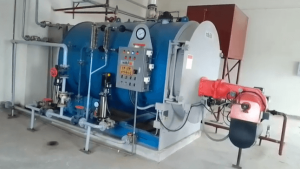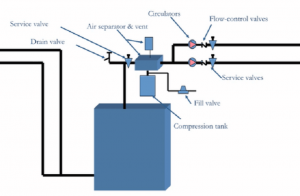Disclosure: As an Amazon Associate, I earn from qualifying purchases. Learn more
A crawl space heater is an effective tool to prevent pipes from freezing in your home. By maintaining temperatures above the freezing point, these heaters can provide a simple yet efficient solution to a common winter problem.
In areas where pipes run through unheated spaces, such as crawl spaces, the risk of freezing is significantly high, especially when temperatures dip below 32 degrees Fahrenheit. In these cases, placing a space heater in the crawl space can be a lifesaver.
A 1500W heater, for instance, can be connected to a thermostat control cube, which activates the heater when temperatures fall to critical levels, such as 35 degrees. This method ensures that the space remains just warm enough to prevent freezing without consuming excessive energy.
It’s also vital to remember that space heaters alone may not be sufficient for all scenarios. For optimal protection, combining the use of space heaters with insulation or heat tape is recommended. This approach not only prevents freezing but also provides a more energy-efficient solution.
Insulating pipes, especially those exposed in crawl spaces, attics, and basements, adds an extra layer of protection, keeping them warmer for longer periods.
Safety is paramount when using space heaters. Regularly checking for cracked cords and ensuring the heater is never left unattended are key safety measures.
Also, setting your home’s thermostat to no lower than 55 degrees, even when the house is unoccupied, helps maintain a stable temperature in the crawl space.
Crawl Space Heater To Keep Pipes From Freezing
Crawl space heaters play a pivotal role in preventing pipes from freezing in residential settings. Their effectiveness stems from their ability to maintain a consistent temperature in areas prone to dropping below freezing points.
Types and Features of Crawl Space Heaters
Electric space heaters are commonly used in crawl spaces due to their ease of use and installation. These heaters come in various types, including convection heaters, which warm the air, and radiant heaters, which directly heat objects in their vicinity.
Modern space heaters often feature built-in thermostats for temperature regulation, automatic shut-off systems for safety, and adjustable power settings to suit different space sizes and heating needs.
Installation and Safety Guidelines
Proper installation is key to maximizing the efficiency of a crawl space heater. It is recommended to place the heater in a central location to evenly distribute heat.
Ensuring the heater is on a stable surface and away from any flammable materials is crucial for safety. It’s advised to regularly inspect the heater for any signs of wear and tear, particularly in the wiring and heating elements.
Energy Efficiency and Cost Implications
While space heaters are effective in preventing pipe freezing, they can be energy-intensive. To optimize energy usage, selecting a heater with an energy-efficient rating and using it in conjunction with insulation can reduce overall energy consumption. Cost-wise, electric space heaters are a relatively affordable option, with prices varying based on size, features, and energy efficiency.
Combining with Insulation for Enhanced Effectiveness
For optimal results in preventing pipe freezing, combining the use of space heaters with proper insulation is recommended. Insulation in the crawl space helps retain the heat generated by the heater, reducing the need for continuous operation of the heater and thereby saving on energy costs.
This dual approach not only ensures pipes remain unfrozen but also contributes to a more energy-efficient heating solution.
Space Heater Efficacy in Pipe Freeze Prevention
Space heaters are a popular choice for preventing pipes from freezing in colder climates. Their efficiency largely depends on the type of heater, its placement, and the ambient conditions of the space.
Comparatively, they are often seen as a more immediate solution than other methods like insulation or heat tape. The ideal setting for a space heater to prevent pipe freezing maintains a steady temperature above the freezing point without overburdening the energy consumption. This balance is crucial to ensure both effectiveness and safety.
Users should be aware of the risks associated with space heaters, such as fire hazards and carbon monoxide poisoning in fuel-based heaters.
Strategic Heater Placement in Crawl Spaces
The effectiveness of a space heater in a crawl space hinges on its strategic placement and usage. Guidelines suggest that the heater should be positioned to evenly distribute heat, particularly near vulnerable pipes. The number of heaters needed depends on the size of the crawl space and the insulation level.
Duration and intensity of heating should be sufficient to maintain a stable temperature that prevents freezing.
Different pipe materials react differently to temperature changes; for instance, copper pipes might need more consistent heating compared to plastic ones.
Adequate ventilation must be ensured to prevent any buildup of dangerous gases or overheating.
Alternatives for Pipe Protection
While space heaters are a direct method to prevent pipe freezing, there are several alternative techniques worth considering. Insulation stands out for its ability to maintain a steady temperature around the pipes.
Heat tape is another effective solution, particularly for pipes that are exposed or in areas prone to extreme cold. These methods are not only cost-effective but also offer a more permanent solution compared to space heaters.
The suitability of these alternatives varies with different home layouts, and in many cases, a combination of insulation, heat tape, and space heaters can offer the most comprehensive protection against pipe freezing.
Assessing Space Heater Risks
Space heaters, while effective, come with their own set of safety concerns. The primary risks include overheating and potential fire hazards. It is crucial to choose space heaters with built-in safety features like automatic shut-off mechanisms and to ensure they are placed away from flammable materials.
Regular maintenance checks are also important to ensure the heater is functioning correctly. Recommendations for safe heater models often include those with certification from recognized safety organizations.
Following best practices for overnight usage, such as not leaving heaters on unattended or in enclosed spaces, is essential for preventing accidents.

